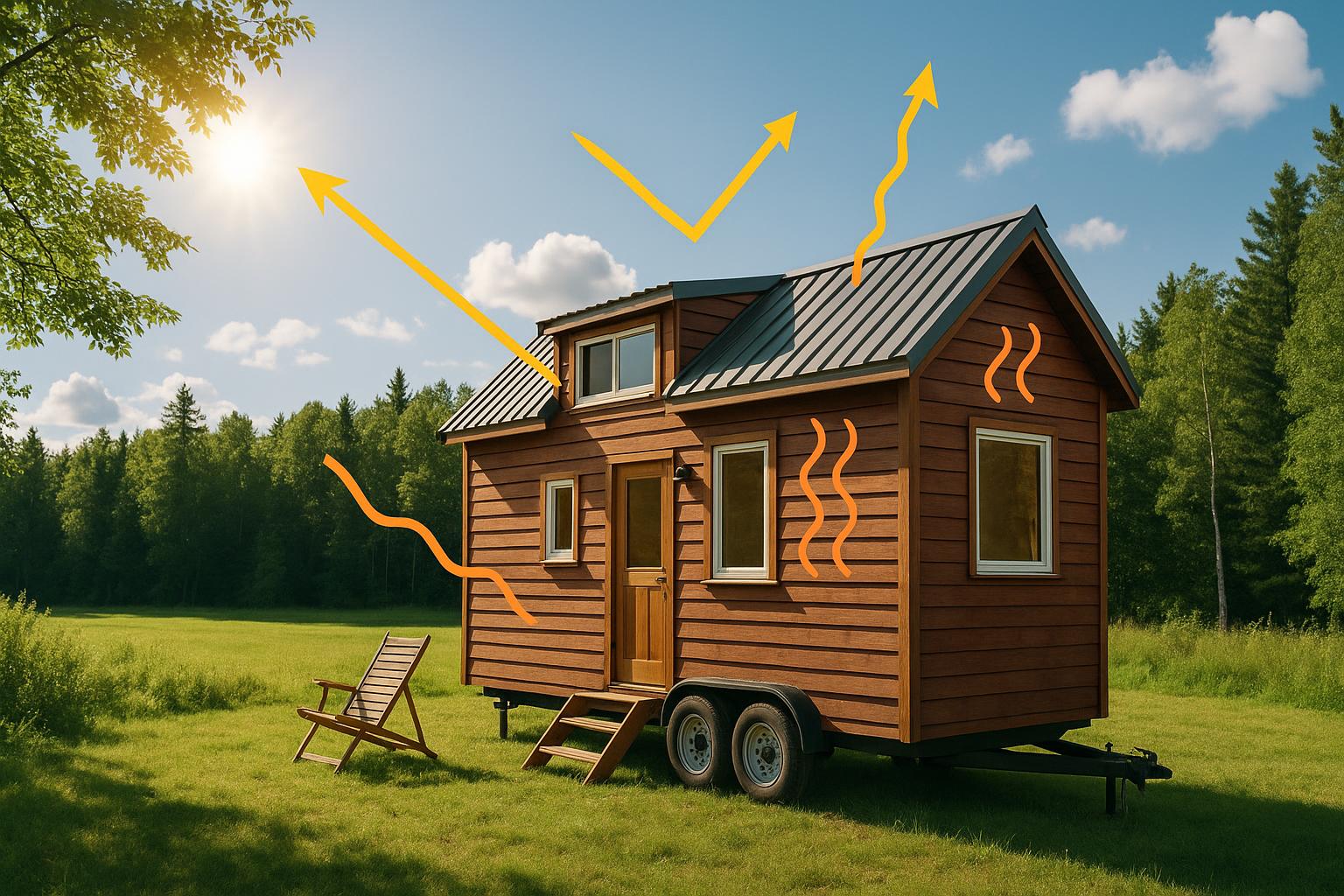
Passive Cooling for Tiny Home Design in the Canadian Climate: How to Achieve Summer Comfort and Energy Efficiency
Estimated reading time: 8 minutes
Key Takeaways
- Energy Efficiency: Passive cooling techniques significantly reduce energy consumption and lower utility bills.
- Enhanced Comfort: Strategic design using natural ventilation, shading, and thermal mass delivers improved summer comfort.
- Canadian Climate Adaptability: Tailored methods help tiny homes overcome temperature swings and long sunny days.
- Sustainable Living: Less reliance on air conditioning means reduced carbon emissions and a smaller environmental footprint.
- Practical Design Tips: Proper home orientation, insulation, and material selection are essential for effective passive cooling.
Table of contents
- Introduction: Passive Cooling, Summer Comfort, and Canadian Tiny Home Design
- Understanding Passive Cooling: Energy Efficiency and Tiny Homes
- Challenges of Cooling Tiny Homes in the Canadian Climate
- Design Methods and Tips for Passive Cooling in Tiny Homes
- Maximizing Energy Efficiency through Passive Cooling
- Case Studies: Passive Cooling Success in Canadian Tiny Homes
- Conclusion: Passive Cooling is the Key to Comfortable, Efficient Tiny Homes
- Frequently Asked Questions
Introduction: Passive Cooling, Summer Comfort, and Canadian Tiny Home Design
Passive cooling is a natural approach to keeping indoor temperatures low without relying on mechanical air conditioning. It uses design strategies such as shading, ventilation, and thermal mass, ensuring that interiors remain cool and comfortable during the hottest months. This method is especially vital in tiny homes where every square foot counts, and temperatures can soar quickly in the Canadian summer.
For more detailed insights, refer to benefits of passive house construction and active vs passive cooling debates. These resources explain how passive strategies can slash energy bills, lower environmental impact, and deliver superior indoor comfort even during heat waves.
Understanding Passive Cooling: Energy Efficiency and Tiny Homes
Passive cooling regulates indoor temperatures using the natural elements—shade, wind, and thermal mass—rather than mechanical devices. This approach allows tiny homes to capitalize on:
- Optimized window placement to capture breezes;
- Effective shading through overhangs, awnings, and greenery;
- Material choices that absorb and slowly release heat.
Using passive cooling not only curbs the need for traditional air conditioning but also supports remarkable energy efficiency—a crucial benefit in the face of rising energy costs and environmental concerns. Check out more on this topic at Talius.
Challenges of Cooling Tiny Homes in the Canadian Climate
In Canada, summer comfort is challenged by various factors:
- Wide Temperature Swings: Mornings can be cool while afternoons may exceed 30°C.
- Elevated Humidity: Especially in southern provinces, where humidity amplifies the perception of heat.
- Prolonged Sun Exposure: Extended daylight drives significant heat gain indoors.
Tiny home design compounding these issues includes:
- Less insulation and thermal mass, resulting in quicker heat gain and loss;
- A high surface area to volume ratio that exposes more of the home to the harsh sun;
- Challenges in managing airflow effectively.
For insights on tiny home living and design benefits in Canada, visit this guide.
Design Methods and Tips for Passive Cooling in Tiny Homes
Effective passive cooling in tiny homes hinges on comprehensive design strategies. Consider these methods:
- Home Orientation: Align main windows with prevailing breezes and minimize east/west exposures to reduce direct sun impact. (Design tips)
- Shading Devices: Install awnings, overhangs, and exterior blinds to block the most intense sunlight. Deciduous trees can also provide seasonal shading.
- Ventilation Strategies: Employ cross-ventilation and stack ventilation to let hot air escape while drawing in cool air naturally. Techniques like nighttime flushing can dramatically reduce indoor heat.
- Thermal Mass and Material Selection: Use materials like concrete, stone, masonry, or brick that absorb and gradually release heat, smoothing out temperature extremes.
- Insulation and Airtightness: High R-value windows, continuous exterior insulation, and meticulous air sealing are key to maintaining stable indoor climates.
- Cool and Green Roofs: Reflective or vegetated roofs can significantly cut down on solar heat gain, enhancing indoor comfort and energy efficiency.
These design methods integrate natural resources and innovative architectural solutions to keep tiny Canadian homes cool, even during the peak of summer. For additional ideas, see resources at Adustart.
Maximizing Energy Efficiency through Passive Cooling
Passive cooling not only keeps spaces comfortable but also plays a crucial role in enhancing energy efficiency. The advantages include:
- Reduced Air Conditioning: Lower reliance on electricity-driven cooling systems means substantial cost savings.
- Environmental Sustainability: By cutting down on power usage, households contribute to lower greenhouse gas emissions.
- Long-Term Home Resilience: Consistent indoor temperatures lead to less wear on electronic cooling systems and better indoor air quality.
In tiny homes, where every watt counts, these passive strategies yield rapid and significant benefits. For more on energy efficiency, read up at Adustart Energy Efficiency.
Case Studies: Passive Cooling Success in Canadian Tiny Homes
Real-world examples highlight the transformative benefits of passive cooling:
Example 1: In Toronto, an earth tube ventilation system cooled incoming air by 6.8°C, eliminating the need for mechanical cooling in many instances. Learn more.
Example 2: Several tiny homes built to the Passive House standard retained stable interior temperatures during record heat waves, thanks to superior insulation and cross-ventilation techniques. Details can be found at Just Working.
Example 3: The use of exterior shading screens in tiny homes resulted in indoor temperature drops of up to 13°C, vastly improving summer livability. Additional insights are available at Talius.
These case studies underscore that well-conceived passive cooling is not only practical but essential for ensuring both comfort and energy efficiency in tiny homes across Canada.
Conclusion: Passive Cooling is the Key to Comfortable, Efficient Tiny Homes
Passive cooling offers a proven pathway to achieving summer comfort and energy efficiency in tiny home design. By integrating smart shading, proactive ventilation, the use of thermal mass, and high-performance insulation, homeowners can create spaces that are both inviting and sustainable.
Summary of techniques:
- Strategic home orientation and window placement
- Effective shading devices and landscaping
- Optimized ventilation practices
- Material selection focused on thermal mass
- High-quality insulation and airtight construction
- Implementation of cool or green roofing solutions
For anyone planning or renovating a tiny home in Canada, these strategies provide a robust framework for achieving both comfort and sustainability.
Discover more about tiny home living and building practices at Adustart Tiny Home Living Guide.
Frequently Asked Questions
Q1: What is passive cooling?
A: Passive cooling involves using natural processes—such as ventilation, shading, and thermal mass—to lower indoor temperatures without mechanical air conditioning.
Q2: How does passive cooling benefit tiny homes?
A: Tiny homes benefit from rapid temperature changes; effective passive cooling maintains comfortable indoor climates while reducing energy consumption and costs.
Q3: Is passive cooling effective in extreme Canadian summers?
A: Yes, when combined with smart design strategies such as proper orientation, shading devices, and quality insulation, passive cooling can handle even the most challenging temperature swings.
Q4: Can I retrofit an existing tiny home with passive cooling features?
A: Many strategies such as installing awnings, enhancing ventilation, and adding reflective roofing can be incorporated into existing structures to improve passive cooling performance.

Leave a Reply